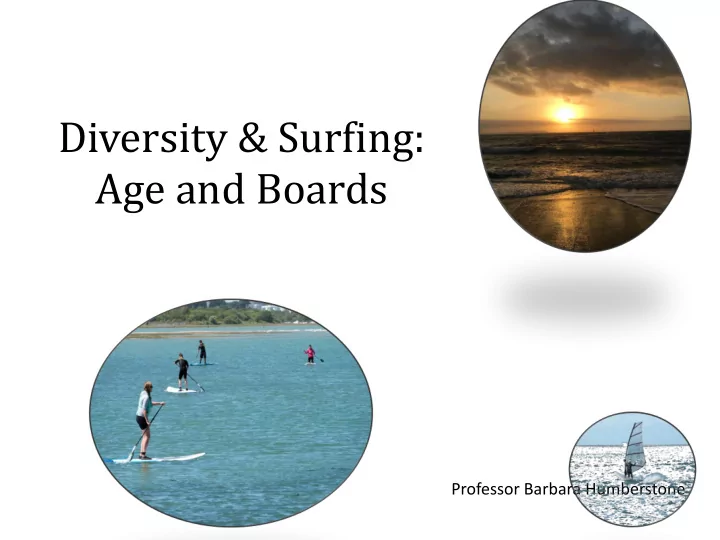

Diversity & Surfing: Age and Boards Professor Barbara Humberstone
windsurfing Windsurfing is a a surface water sport that combines elements of surfing and sailing ‘Wikipedia’ (Calshot, Solent, UK) How technology can dissolve the boundary between us as Humans & more-than-human sea and its energies
Summary In Weymouth harbour England
Windsurfing • https://m.youtube.com/watch?v=aZ- 37pz9zWk%23 • 2”17
Stand Up Paddle boarding-SUPing • Standup paddle surfing & standup paddle boarding off shoots of surfing in Hawai ‘Wikipedia’ Woman with dog, Calshot, UK
SUPing in Raglan harbour, NZ
… this business of getting older, in a way, is a bit of a pig. You’re stiffer and you’re slower; you can’t quite achieve what you did before.(Bonnington, 2017, p.5)
Who • Self and human/non- human/ older windsurfers/SUPers/ kayakers : subjectivities • Social groups, casual sailing/SUPing, cruising • Relations between human and non-human
Material/technologies • Boards/rigs/paddles • Bodies • Adaptations
Emplacement-Place/space/time • Liminal space-border • Coast-SE England- France • Where I have been a participant in Northern hemisphere • June-October summer • Days, weeks
Exploration of ageing embodiment Sensorial experiences Affect-experience of senses Memory, nostalgia, joy, pain
Contexts: research background ageing/ windsurfing-SUPing • Positivistic and medicalised • Statistics-predictions by 2050-1 in 3 over 60s • Critiques of dominant forms of research • Interpretative research can inform policy and practice that explores embodied and emplaced experiences of older people engagements with surface water –based activities
Methodology Reflexive narrative: Ethnography/Autoethnography “there is a combination of autoethnography with ethnography so that ‘others’ and relations with others move in and out of the centre of the research as the self moves fluidly from centre to periphery of the research.” Humberstone & Nicol (2019) Autoethnography is a permeable approach and there is no one way of doing it (Gearity, 2014).
Method Ethnography/Autoethnography ‘At an individual and collaborative level, reflexivity helps us remain engaged with our subjective assumptions and experiences, and negotiate how the experiences, ideas, conversations, theories we have gathered through our research have all folded into and through us (St Pierre, 1997). It is about developing “situated knowledges” (Haraway, 1991), that reveal how researchers themselves shape projects and findings. Far from an effort to discredit the subjective-ness of research, developing a strong reflexivity is a strength.’ (Olive, in press)
Memory Memory has a powerful influence on autoethnographic processes. Giorgio (2016: 406-207) asserts that, “as autoethnographers, we use memory for much of our data; through memory we ground our analyses; our memories inform our epistemologies and methodologies”. She continues “I re-live and re-imagine, shaping my memories into autoethnography, a suturing of lived experience with theory, (and) memory with the forgotten.” Autoethnographic research can not only enable exploration of cultural contexts of life span, but enable experiences of place and embodiment to be sensorialised and (re) presented in various ways.
(Re)-presentation lisahunter & Emeril,( 2016, p.39) propose and ask , “ Using the senses to create a text and creating a text that can be engaged sensorially: can it be touched, smelt, tasted, can a research text evoke pleasure or pain, where/when is it in place/space/time, how can a text capture me (turn me)?”
Re-presentation Creative non-fiction narrative • Narrative based upon an event told to me about ‘being rescued’ • Highlights the experiences of an older woman windsurfer 69 yrs ‘ Being rescued’ Humberstone, 2011,165-166 )
Is narrative sufficient? Development oƒ theory? • Do these narratives speak to the reader/listener?-It depends on the nature of the narrative and the intention of the writer/researcher. • Synthesising theory may develop thinking and connections.
Sensual & sensory geographies of emplacement Decrepit (crumbly) Empowered (sense of being) • Diminishing strength • Elements (wind)/blue space • Achy joints/arthritis • Sense of speed/movement (pain) (pleasure, joy) • Diminishing hearing/sight Materiality • Equipment/board-rig • Artificial joints • Knee supports Inspired by lisahunter & emerald (2016) framework
Bodies & Technologies - Blurring boundaries ‘Paying attention to space ‒ time re-imaginings ( Foucault, 1986 ) and Haraway’s (1985 ) classic ‘cyborg manifesto’, I argue that as one windsurfs, surfs or sails (kayaks) one becomes sea- cyborg/mermaid or merman, connecting empathetically with elemental seascapes. In exploring the cyborg concept, the blurring of boundaries between human and non-human are explored.’ (Humberstone, 2019) .The more so as one ages and becomes less strong and draws on artificial material aids/equipment. How technology can dissolve the boundary between us as humans and more-than-human sea (land) and its energies
References Bonnington, C. 2017. Ascent. A life spent climbing on the edge. London: Simon and Schuster Gearity, B. T. (2014). Autoethnography. In L. Nelson, R. Groom and P. Potrac (Eds.) Research Methods in Sports Coaching. (pp.205-216). London: Routledge. Haraway, D. (1985) Manifesto for cyborgs: Science , technology and socialist feminism in the late 20 th Century. Haraway, D. J. (1991). Simians, cyborgs, and women: The reinvention of nature . London: Free Association Books. Humberstone, B. and Nicol, R. (2019) Autoethnography: Senses, embodied narratives and memory In B. Humberstone & H.Prince (Eds.) Research Methods in Outdoor Studies, Routledge. lisahunter & elke emerald (2016). Sensory narratives: capturing embodiment in narratives of movement, sport, leisure and health, Sport, Education and Society, 21 (1), 28-46. Olive, R. (2019) Thinking the social through myself: Reflexivity in research practice. In B. Humberstone & H.Prince (Eds.) Research methods in outdoor studies. London : Routledge. St Pierre, E.A. (1997) Methodology in the fold and the irruption of transgressive data. Qualitative Studies in Education, 10 (2), 175–189.
Recommend
More recommend